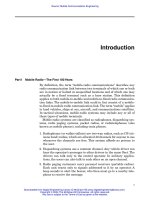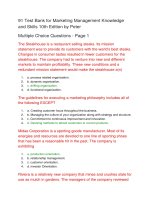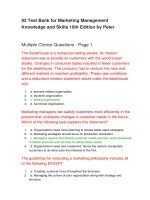Project management theory and practice, second edition by gary l Richardson(PRADYUTVAM2)CPUL
Bạn đang xem bản rút gọn của tài liệu. Xem và tải ngay bản đầy đủ của tài liệu tại đây (6.16 MB, 654 trang )
Project
Management
Theory and
Practice
Second Edition
Gary L. Richardson
Project
Management
Theory and
Practice
Second Edition
Project
Management
Theory and
Practice
Second Edition
Gary L. Richardson
CRC Press
Taylor & Francis Group
6000 Broken Sound Parkway NW, Suite 300
Boca Raton, FL 33487-2742
© 2015 by Taylor & Francis Group, LLC
CRC Press is an imprint of Taylor & Francis Group, an Informa business
No claim to original U.S. Government works
Version Date: 20140626
International Standard Book Number-13: 978-1-4822-5497-6 (eBook - PDF)
This book contains information obtained from authentic and highly regarded sources. Reasonable efforts have been
made to publish reliable data and information, but the author and publisher cannot assume responsibility for the validity of all materials or the consequences of their use. The authors and publishers have attempted to trace the copyright
holders of all material reproduced in this publication and apologize to copyright holders if permission to publish in this
form has not been obtained. If any copyright material has not been acknowledged please write and let us know so we may
rectify in any future reprint.
Except as permitted under U.S. Copyright Law, no part of this book may be reprinted, reproduced, transmitted, or utilized in any form by any electronic, mechanical, or other means, now known or hereafter invented, including photocopying, microfilming, and recording, or in any information storage or retrieval system, without written permission from the
publishers.
For permission to photocopy or use material electronically from this work, please access www.copyright.com (http://
www.copyright.com/) or contact the Copyright Clearance Center, Inc. (CCC), 222 Rosewood Drive, Danvers, MA 01923,
978-750-8400. CCC is a not-for-profit organization that provides licenses and registration for a variety of users. For
organizations that have been granted a photocopy license by the CCC, a separate system of payment has been arranged.
Trademark Notice: Product or corporate names may be trademarks or registered trademarks, and are used only for
identification and explanation without intent to infringe.
Visit the Taylor & Francis Web site at
and the CRC Press Web site at
CONTENTS
Prefacexxi
Acknowledgmentsxxiii
Authorxxv
Part 1
Conceptual Overview of the Project Environment
Chapter 1Introduction
3
1.1 Project Management
4
1.2 Role of the PM
4
1.3 PM Skills
5
1.3.1 Success Management
6
1.4 Book Content and Organization
6
1.4.1 Book Structure
7
Appendices9
References9
Chapter 2
Evolution of Project Management
11
2.1 Early History of Project Management
12
2.2 Application of Analytical Science
12
2.3 Frederick Taylor and Scientific Management
12
2.4 Frank and Lillian Gilbreth
14
2.5 Henry Gantt
14
2.6 Mary Parker Follett
15
2.7 Elton Mayo
15
2.8 Phases of Project Management Evolution
16
2.9 Project Management Challenges
21
2.10 Project Management Benefits
21
2.10.1 At the Macrolevel
21
2.10.2 At the Microlevel
22
References22
v
vi • Contents
Chapter 3
Project Management Body of Knowledge
23
3.1 High-Level Overview
23
3.2 History of PMBOK® Guide Development
24
3.3 Structure of the PMBOK® Guide24
3.3.1 Project Domains
24
3.3.2 Knowledge Areas (KAs)
28
3.4 Introductory Vocabulary Terms
32
3.5 Ancillary Models
34
3.6Summary
34
Reference35
Chapter 4
Industry Trends in Project Management
37
4.1 Standardizing Project Management
37
4.2 Enterprise Project Management
37
4.3 EPM in Operation
39
4.4 Implementation and Advantages of EPM
40
4.5 Other Trends Impacting Project Management
40
4.6 Project Management Perspective
41
Discussion Questions
42
References42
Chapter 5
Project Types
43
Reference47
Chapter 6
Project Organization Concepts
49
6.1 PM’s Role
49
6.2 Reporting Relationships
50
6.3 Team Resources
50
6.4 Team Productivity and Size
51
6.5 Team’s Physical Location Issues
51
6.6 Virtual Organizations
53
6.7 Organizational Culture
54
6.8Summary
55
References55
Chapter 7
Project Life Cycle Models
7.1 Overview of Project Methodologies
7.2 Life Cycle Management Process
7.2.1 Feasibility Review
7.2.2 Project Plan
7.2.3 Logical versus Physical Design
7.2.4 Quality Control and Quality Assurance
7.2.5 Monitor and Control
7.2.6 Periodic Status Reviews
7.2.7 Milestone or Stage Gate Reviews
7.2.8 Project Close
7.2.9 Project Communication Processes
7.2.10 Life Cycle Models
7.2.11Templates
57
57
58
59
59
59
60
60
60
60
60
61
61
62
Contents • vii
7.3 Key Project Management Artifacts
62
7.3.1Initiating
62
7.3.2Planning
62
7.3.3Execution
63
7.3.4 Monitoring and Control
63
7.3.5Baseline
63
7.4 Project Methodology Models
63
7.5 Summary Points
65
References67
Chapter 8
Quick Start Example
69
8.1 Project Management Work Packages
69
8.2 WP Dictionary
69
8.3 Multiple WPs
71
8.4 Psychology of Estimating
72
8.5Procrastination
72
8.6 Developing the Whole Project View
73
8.7 Project Scope
74
8.8 Example: Pool Project Mechanics
75
8.9 Quick Start Wrap-Up
79
Discussion Questions
79
Reference79
Concluding Remarks for Part 1
80
Part 2
Projects as State Change Vehicles
Chapter 9
Role of Projects in the Organization
85
9.1 Project Valuation Models
85
9.2 Project Selection Strategies
88
9.3Conclusion
90
References91
Chapter 10 Project Initiation
10.1Introduction
10.2 Environmental Factors to Consider
10.2.1 User Involvement
10.2.2 Executive Management Support
10.2.3 Experienced PM
10.2.4Communications
10.2.5 Clear Business Objectives
10.2.6 Minimized Scope
10.3 Other Success Factors
10.3.1 Agile Development Approaches
10.3.2 Existence of a Standard Process Infrastructure
10.3.3 Use of a Standard Methodology
10.3.4 Reliable Time Estimates
10.3.5 Availability of Appropriate Skills
10.3.6 Industry and Organizational Culture
93
93
98
99
99
100
101
101
102
103
103
104
104
105
105
105
viii • Contents
10.4 Project Success Trends
106
10.5 Forecasting the Success of Technology Projects
106
10.6Conclusion
109
References109
Part 3
Defining the Triple Constraints
Chapter 11 Project Plan Development
115
11.1 Arguments for Planning
116
11.1.1 Project Monitoring and Control
117
11.1.2 Conflicting Expectations
117
11.1.3 Overlooking the Real Solution
117
11.1.4 Competing Solutions
118
11.1.5 Misaligned Goals
118
11.1.6 Quality Solutions
118
11.1.7Summary
118
11.2 Plan Process and Components
118
11.3 Initial Planning View
119
11.4 Plan Artifacts
120
11.5 Real-World Planning Process
121
11.6Conclusion
121
References122
Chapter 12 Scope Management
123
12.1 Defining Project Work Units
124
12.2 WP Planning Variables
125
12.3 Multiple WPs
126
12.4 Developing the Project View
126
12.5 Developing Project WBS
127
12.6 WBS Mechanics
130
12.6.1 WBS Numbering Scheme
132
12.6.2 WBS Dictionary
133
12.6.3 Other WBS Views
133
12.6.4 Tracking Status of the WP
136
12.7 WBS Construction Mechanics
137
12.8 Requirements “ibilities”
139
12.9 Moving Forward
141
References142
Chapter 13 Time Management
13.1 Defining Project Work Activities
13.1.1 Define Activities
13.1.2 Activity Sequencing
13.1.3 Estimating Activity Resources
13.1.4 Estimate Activity Duration
13.2 Tips for Accurate Estimating
13.2.1 Types of Estimates
13.3 Estimating Techniques
13.3.1 Expert Judgment
143
144
145
146
146
146
147
148
149
149
Contents • ix
13.3.2 Analogous Estimating
150
13.3.3 Heuristic Estimating
150
13.3.4 Delphi Technique
151
13.3.5 Parametric Estimating
152
13.3.6 Phased Estimating
153
13.3.7 Effort Distribution Estimating (Top-Down)
155
13.3.8 Bottom-Up Estimating
156
13.3.9 Monte Carlo Simulation
157
13.4 Activity Sequencing
158
13.4.1 Activity on Arrow
158
13.4.2 Activity on Node Model
159
13.5 Time Calculation
159
13.6 Network Mechanics
160
13.7 Establishing the Project Activity Sequence
161
13.7.1 Sample Project Definition
161
13.8 Forward Pass Calculation
162
13.9 Backward Pass Calculation
162
13.10 Defining Critical Path
164
13.11 Manipulating the Schedule
165
13.11.1 Automated Calculation Tools
165
13.12 Formatting Activity Results
166
13.13 Which Diagram Format Wins?
166
13.14Summary
168
13.15 Estimating Checklist
168
Problems169
References170
Chapter 14 Cost Management
14.1 Project Cost Planning Basics
14.2 Cost Planning
14.3 Cost Accuracy
14.4 Organizational Overhead
14.5 Scope, Time, and Cost Alignment
14.5.1 Scope Replanning
14.5.2 Fast Tracking
14.5.3 Schedule Crashing
14.6 Indirect Costs
14.7 Resource Alignment
14.8 Budget Reserves
14.8.1 Plan Dynamics
14.8.2 Risk Events
14.8.3 Management Reserve
14.9 Resources Have Different Colors
14.9.1 Budget Expense Categories
14.9.2 Assets versus Expenses
14.9.3 Budget Cost Components
14.10 Management Approval and Baselines
14.11Summary
173
174
174
175
176
176
176
176
177
178
180
183
183
184
184
185
185
186
187
187
188
x • Contents
References189
Concluding Remarks for Part 3
189
Part 4
Planning Support Processes
Chapter 15 Human Resource Management
195
15.1 HR Planning
195
15.2 HR in Execution
196
15.3 Acquire Project Team
196
15.4 Project Organizations
198
15.4.1 Dotted Lines
199
15.4.2 People Issues
199
15.5 Role Specifications
200
15.6 Responsibility Assignment Matrix
200
15.7 Resource Histograms
201
15.8 Staffing Management Plan
202
15.9 Motivation Theory
202
15.10 Individual Motivation Theories
203
15.11 Team Motivation
206
15.12 Hygiene Dissatisfiers
207
15.13 Employee Satisfaction
207
15.14 Conflict Management
208
15.14.1 Conflict Sources
209
15.15 Negotiation Skills
210
15.16 Techniques for Handling Conflict
211
15.17 Conflict Management Scenario Case
212
15.18 Leader versus Manager?
213
15.19 Attributes of a Leader
213
15.20 Training Programs
214
15.21Summary
215
References216
Chapter 16 Project Communications
16.1Introduction
16.2 Engaging Employees: A Case Study
16.3 Communications Management Processes
16.4 Plan Communications
16.5 Distribute Information
16.6 Report Performance
16.7 Human Communications Model
16.8 Communication Channels
16.9 Communicating Information
16.10 Improving the Effectiveness of Communication
16.11 Effective Listening
16.12 Barriers to Effective Communication
16.13 Communication Tension
16.14 Communication Styles
16.15 Communications: The Impossible Goal?
16.16Conclusion
217
217
217
218
218
220
221
221
225
227
227
227
228
228
229
229
230
Contents • xi
Discussion Questions
230
References231
Chapter 17 Stakeholder Management
233
17.1Introduction
233
17.2 Identifying Stakeholders
234
17.2.1 Communications Planning
234
17.2.2 Stakeholder Composition
235
17.2.3 Communication Steps
235
17.2.4 Content Definition
236
17.2.5 Delivery Media
236
17.2.6 Success/Failure Syndrome
238
17.3 Stakeholder Classification
239
17.3.1 Managing Stakeholder Expectations
240
17.4 Project Operational Integration
241
17.5 Final Thoughts
243
References243
Chapter 18 Procurement Management
245
18.1Introduction
245
18.2 Procurement Management
245
18.3 Make or Buy Decision
246
18.4 Procurement Management Processes
247
18.5 Planning for Procurement
248
18.5.1 Planning Stage Outputs
248
18.5.2 Procurement SOW
249
18.6 Conduct Procurements
249
18.6.1 Requests for Information
250
18.6.2 Requests for Proposals
250
18.6.3 Requests for Quotation
250
18.6.4 Invitations for Bid
251
18.6.5 Invitation to Negotiation
251
18.7 Bidding Process
251
18.8 Selecting Sellers
251
18.9 Contract Negotiation
252
18.10Contracts
254
18.11 Conduct Procurement
256
18.12 Procurement Audits
256
18.13 Contract Review and Reporting
256
18.13.1 Record Keeping and Audits
257
18.14 Close Procurements
258
18.15 Procurement of Human Services
258
18.16 Ranking Vendor Proposals
259
18.16.1Instructions
260
18.17Summary
261
Discussion Questions
262
Glossary of Procurement Terms
262
Appendix: Contractual Legal Terms
264
References265
xii • Contents
Chapter 19 Quality Management
267
19.1Introduction
267
19.2 Evolution of Quality
267
19.3 Definition of Quality
268
19.4 Project Quality Management
270
19.5 Quality Perspective
270
19.6 Implications for Project-Planning Stage
271
19.7 Quality Planning
272
19.7.1 Quality Policy
272
19.7.2 Quality Objectives
273
19.8 Quality Management Components
273
19.9 Quality Definition
274
19.10 Quality Design
275
19.11 Quality Assurance
275
19.12 Quality Control
276
19.13 QA versus QC Operational Roles
276
19.14 Quality Gurus
277
19.14.1 Edwards Deming
277
19.14.2 Joseph Juran
278
19.14.3 Philip Crosby
278
19.14.4 Kaoru Ishikawa
279
19.14.5 Armand Feigenbaum
279
19.14.6 Genichi Taguchi
279
19.14.7 Six Sigma
279
19.14.8 Other Gurus
280
19.15 Quality Management Programs
280
19.15.1 ISO 9000
280
19.15.2 Zero Defects
280
19.15.3 Total Quality Management
280
19.15.4 Six Sigma
281
19.16 PMBOK® Guide Quality Process Model
286
19.17 Other Programs
286
19.18 Evaluating Quality
287
19.18.1Benchmarking
287
19.19 Continuous Improvement
288
19.20 Failure Mode and Effects Analysis
288
19.21 Quality Tools
289
19.22 Other Quality Analysis Techniques
292
19.22.1 Design of Experiments
292
19.22.2 Quality Function Deployment (QFD)
292
19.23 Organizational Roles and Responsibilities
294
19.24 Issues in Quality Management
295
19.25 Toyota Quality Perspective
296
19.26 Future of Quality Management
298
19.27 Worksheet Exercise: Are You Meeting
Quality Goals?
299
Discussion Questions
301
References301
Contents • xiii
Chapter 20 Risk Management
303
20.1Introduction
303
20.2 Risk Management Process
307
20.3 Risk Management Planning
308
20.3.1 Developing an RBS
310
20.4 Risk Identification
310
20.5 Qualitative and Quantitative Risk Analysis
314
20.6 Risk Assessment
315
20.7 Risk Contingency Budget
319
20.8 Risk Response Planning
319
20.9 Risk Control
321
20.10 Risk Events versus Issues
321
20.11 Project Risk Assessment Worksheet
322
20.12 Risk Case Study
322
20.12.1 Mishap Foils Latest Attempt at a 25-Mile Skydive
322
20.13Conclusion
324
Discussion Questions
325
References325
Chapter 21 Integrating the KAs
21.1 Reviewing Plan Components
21.2 Plan Approval Process
21.2.1 Review Major Planning Artifacts
21.3 Project Management Plan
21.4 Financial and Control Structures
21.4.1 Scope Reserve
21.4.2 Risk Reserve
21.4.3 Level of Effort
21.4.4Overhead
21.4.5 Management Reserve
21.4.6Profit
21.5 Budget Structure and Format
21.6 Control Structure
21.7 Documentation Plan Packaging
21.8 External Communication Process
21.9 Planning Stage Close
Discussion Questions
327
327
328
329
329
330
333
333
333
334
334
335
335
336
337
338
339
340
Part 5Advanced Planning Models
Chapter 22 Analyzing Variable Time Estimates
343
22.1 History of Variable Time Estimates
343
22.2 Modifying PERT for Commercial Projects
345
22.3 Defining Variable Time Estimates
346
22.4 Central Limit Theorem
348
22.5 Triangular Distributions
349
22.6 Calculating Probability of Completion
351
22.7Summary
352
References353
xiv • Contents
Chapter 23 Project Simulation
355
23.1 Traditional Time Modeling Tools
355
23.1.1 Near-Critical Path Activities
355
23.1.2 Task Existence Risk Modeling
356
23.1.3 Conditional Activity Branching
356
23.1.4 Correlation between Task
Durations
356
23.2 Simulation in Risk Management
356
23.3 Pertmaster Modeling
358
23.4 Other Pertmaster Metrics
360
23.5Summary
361
References362
Chapter 24 Critical Chain Management Model
363
24.1Introduction
363
24.2 CCM Concepts
364
24.3 CC Mechanics
365
24.4 CCM Model
367
24.5 Principles of the CC Model
368
24.6 Buffer Management
369
24.6.1 Buffer Types
370
24.7 Building the CC Schedule
372
24.8 Resource Allocation
373
24.9 Implementation Challenges
374
24.9.1 Organizational Barriers
374
24.9.2 Leadership Challenges
377
24.9.3 Skill Requirements
380
24.10 Buffer Management
383
24.11 Organizational Challenges of the CC
383
24.12 CC Implementation Strategies
384
24.13Conclusion
385
References386
Part 6
Project Execution: Working the Plan
Chapter 25 Project Execution Management
25.1Introduction
25.1.1 Magic Twelve Success Indicators
25.2 Status View
25.2.1 Status-Tracking Processes
25.2.2 Turning the Management Control Knobs
25.3 Human Relations and Communications Issues
25.3.1 Team Acquisition
25.3.2 Manage Project Team
25.3.3 Meetings as Information Sources
25.4 Project Team Member Dissatisfiers
25.5 Project Team Member Motivators
389
389
389
391
391
393
395
395
398
399
402
403
Contents • xv
25.6Conclusion
404
Discussion Questions
404
References405
Part 7
Monitoring and Controlling Techniques
Chapter 26 Change Management
411
26.1Introduction
411
26.2 Integrated Change Control
411
26.3 Change Control System
413
26.4 Configuration Management
415
26.5 Change Management Workflow
416
26.6 External Communication Issues
417
26.7 Change Request Checklist
419
26.8Summary
420
References420
Chapter 27 Project and Enterprise Metrics
421
27.1Introduction
421
27.2Fundamentals
421
27.2.1 Alignment with Organization Goals
422
27.3 Alignment with Organizational Maturity
422
27.4 Drivers of Performance and Change
424
27.5 KPI Categories
424
27.6 Metrics Evaluation Criteria
426
27.7 Establishing a Baseline and Setting Targets
427
27.8 Beware of the Metrics Pitfalls
428
27.9Mechanics
430
27.9.1 Miscellaneous Issues
430
27.10 Industry Standard Metrics for Monitoring
and Control
433
27.11Conclusion
434
References434
Chapter 28 Earned Value Management
28.1 Basic Principles
28.2 Calculating EV Parameters
28.3 Interpreting EV Parameters
28.4 EVM Criteria
28.5 EVM Simplified
28.6 EVM for Commercial Applications
28.7 Emerging Applications of EVM
28.7.1 Earned Schedule
28.8 ES Mathematical Formulation
28.8.1 ES Formulae
28.8.2 ES Indicators
28.9 EVM Pros and Cons
28.10Conclusions
435
436
438
439
440
441
442
444
444
445
447
447
448
448
xvi • Contents
Appendix449
A. Summary Review of EV Metrics and Performance
Parameters449
B. EV Formulae and Interpretation
450
C. Using a Summary Project Plan Spreadsheet to Calculate
EV Parameters
450
D. EV Earning Rules
450
Problems451
References453
Further Reading
454
Chapter 29 Tracking Project Progress
455
29.1Introduction
455
29.2 Status Tracking
455
29.3 Tracking Metrics
457
29.4 Information Distribution
458
29.5Control
459
29.5.1 Project Plan
459
29.5.2 Issue Management Process
460
29.5.3 Configuration Management (CM)
460
29.5.4 Integrated Change Control (ICC)
460
29.6 KA Controls
461
29.6.1 Scope Control
461
29.6.2 Schedule Control
461
29.6.3 Cost Control
461
29.6.4 Quality Control
462
29.7 Project Status Tracking Case Study
463
29.8Conclusion
464
References465
Chapter 30 Enterprise Reporting Using the Balanced Scorecard
30.1Introduction
30.2 Scorecard Implementation
30.2.1 Communicating Strategic Objectives
30.2.2 Communicating Strategy
30.2.3 Assigning Responsibility
30.2.4 Aligning Strategy
30.2.5 Process Integration
30.3 BSC Implementation Principles
30.3.1 Best Practices
30.3.2 Barriers to Success
30.4 BSC Model
30.4.1 Financial Perspective
30.4.2 Internal Business Process Perspective
30.4.3 Learning and Growth Perspective
30.4.4 Customer Perspective
30.5 BSC as a Strategic Management System
30.5.1 Overcoming the Vision Barrier
30.5.2 Overcoming the People Barrier
467
467
468
468
468
469
469
469
469
470
470
471
472
473
473
474
474
474
475
Contents • xvii
30.5.3 Overcoming the Resource Barrier
475
30.5.4 Overcoming the Management Barrier
476
30.6 BSC as a Communication Tool
476
30.7 Balancing the BSC Components
476
30.8 Advantages and Disadvantages of BSC
477
30.8.1Advantages
477
30.8.2Disadvantages
478
30.9 Future of the BSC
478
30.10Conclusion
479
References479
Part 8
Closing the Project
Chapter 31 The Closing Process
483
31.1 Project Implementation Review
484
31.1.1 Normal Project Termination
485
31.2 Abnormal Termination
485
31.3 Termination Model
485
31.4 Project Termination Checklist
486
31.5 Project Team and Client Relationship
488
31.6 Creating Lessons Learned Documentation
488
31.7 Lessons Learned Report
488
31.8 Project Team Celebration
489
31.9Conclusion
490
References490
Part 9
Contemporary Topics
Chapter 32 Organizational Maturity
32.1Introduction
32.2 Capability Maturity Model
32.3 SEI’s Capability Maturity Model
32.4 CMM Structure
32.5 CMM Maturity Levels
32.5.1 Initial Level (Level 1)
32.5.2 Repeatability Level (Level 2)
32.5.3 Defined Level (Level 3)
32.5.4 Managed Level (Level 4)
32.5.5 Optimizing Level (Level 5)
32.6 Capability Maturity Model Integration
32.7 Value of Organizational Maturity
32.8 Organizational Project Management
32.9 Overview of OPM3
32.10 OPM3 Components
32.10.1Knowledge
32.10.2Assessment
32.10.3 Evaluation Process
495
495
496
497
498
498
498
499
499
499
499
499
500
502
503
503
503
504
505
xviii • Contents
32.11 Best Practices
505
32.12 Improvement Planning Directory
506
32.13 OPM3 Processes
507
32.14 Applying OPM3 in an Organization
508
32.15 OPM3 Benefits and Case Studies
511
32.16Conclusion
513
References513
Chapter 33 Project Portfolio Management
515
33.1Introduction
515
33.2 Role of PPM
516
33.3 Improving Project Selection Decisions
516
33.4 Improving Visibility of Project Performance
517
33.5 Better Understanding of Project Value
517
33.6 Conducting “What If” Analysis
517
33.7 Project Investment Management
517
33.8 Who Needs a PPM?
518
33.9 PPM Goal Structure
519
33.9.1 Subgoal 1: Strategic Goal Alignment
519
33.9.2 Subgoal 2: Resource Investment Focus
519
33.9.3 Subgoal 3: Better Project Control/Governance
520
33.9.4 Subgoal 4: Efficiency
520
33.9.5 Subgoal 5: Balance
521
33.9.6 Subgoal 6: Value Optimization
521
33.10 Models of PPM
522
33.11 Hybrid Model
523
33.12 Efficient Frontier
523
33.12.1 Project Assessment
524
33.13 Keys to Implementing PPM
525
33.14 PPM Principles
526
33.15 Finding the Approach that Fits
526
33.16 Executive Support
526
33.17 Governance Framework
527
33.18 Value-Measurement Framework
527
33.19 Institute Effective Processes
528
33.20 PPM Implementation Roadmap
528
33.21 External Expertise
529
33.22 Implementation Goals
529
33.23 Key PPM Interfaces
530
33.24 PPM Implementation Challenges
531
33.25 Advantages of Implementing PPM
531
33.26Summary
532
References532
Chapter 34 Enterprise Project Management Office
34.1Introduction
34.2 PMO Functions
34.3 Enterprise Project Management Office (EPMO)
34.4Communication
535
535
535
536
537
Contents • xix
34.5
34.6
34.7
34.8
Performance Metrics
537
Status Reporting
538
EPMO Communication Linkages
539
EPMO Organizational Models
540
34.8.1 Weather Station Model
540
34.8.2 Control Tower Model
541
34.8.3 Resource Pool Model
543
34.8.4 Which Model Is the Right One?
544
34.9 EPMO Maturation Stages
545
34.9.1 EPMO Tools and Technology
546
34.10 Evaluating and Prioritizing New Projects
549
34.11 Weighted Criteria Example
550
34.12Summary
550
References550
Chapter 35 HR Outsourcing
553
35.1Introduction
553
35.2 Management Drivers
554
35.3 First Wave Outsourcing
555
35.4 Offshoring Wave
556
35.5 Issues with Outsourcing Relationships
556
35.6 Outsourcing Success and Failures
557
35.7 Best Outsourcing Practices
558
35.8 Outsourcing Vendor Evaluation Worksheet
562
35.9Conclusion
562
References563
Chapter 36 High-Productivity Teams
565
36.1 Background and Overview
565
36.2 Introduction to TSP Concepts
566
36.3 PP Concepts
567
36.3.1 PP Example
568
36.3.2 Introducing PP to the Team
570
36.4 TP Process
570
36.5 TP Work Objects and Principles
570
36.5.1 TP Launch Structure
571
36.6 TP Launch Details
573
36.7 Teamwork Process
574
36.8 Quality Management
575
36.9 Experience Examples and Evaluation
575
36.10 TSP Qualitative Feedback Results
576
36.11 Future Trends
577
36.12 Large, Multidisciplined Projects
578
36.13Summary
579
References579
Chapter 37 Project Governance
37.1Introduction
37.2 Need for Project Governance
581
581
581
xx • Contents
37.3 Project Governance Definition
582
37.4 Organizational Level Project Governance Principles
583
37.5 Tactical Level Project Governance
584
37.6 Operational Governance Model
585
37.7 Defining Responsibilities
587
37.8 Populating the Project Governance Framework
588
37.9 Governance Life-Cycle Maturity Model
590
37.10 Governance Value Process
592
37.11 Corporate Governance and Project Teamwork (Halas)
594
37.12Commentary
596
37.13Conclusion
596
References597
Part 10
Professional Ethics and Responsibility
Chapter 38 Ethical Project Management Practices
601
38.1 Learning Objectives
601
38.2Introduction
601
38.3 PMI’s Code of Professional Conduct
604
Review Questions
605
Reference609
Appendix A: Financial Metrics
Appendix B: Templates
Appendix C: Project Repository Architecture
611
617
619
PREFACE
Broad interest in the topic of project management has been growing and maturing over the
last 20 years; however, this subject is still in a relatively neophyte maturity stage. The roots
of this effort go back many years in my attempts to install standard project development
methodologies into large organizations. Through all of those past experiences I was involved
with projects of one kind or another. Around 2003, I moved to the University of Houston to
create a project management program, thinking that it would be an easy subject given my
previous experience. However, it soon became obvious that this subject was not well documented in a readable format and students struggled to get a real flavor of the topic. Most of
the textbooks on the market were either too academic, too much IT, or too much real-world
“silver bullet” quick fix advice types. Based on that assessment, the vision of correcting that
oversight began to take shape. After four years of thrashing around with the topic, this text
organization is the result. You the reader will have to decide how well it matches the goal of a
readable overview of project management model theory with a real-world view.
The academic program at the University of Houston is heavily based on the Project
Management Institute’s (PMI) model concepts and that bias formed the foundation for
the text, even though more topics are included in the final scope. Overall, the text material stays reasonably close to the Project Management Body of Knowledge (PMBOK®
Guide) model, but there is also an attempt to show how this model fits the real world. In
this regard, the material in the text is viewed as a companion to the technical guide and
should be of help to someone studying for various project management certifications,
but does not duplicate the breath of definition described in the guide.
There are several project-related model frameworks sponsored by PMI today, and
many of these are covered in various segments of the text. Specifically, the following five
topics are discussed in some detail:
•
•
•
•
•
Work breakdown structures (WBS)
Earned value management (EVM)
Enterprise project management (EPMO)
Portfolio management (PPM)
Professional responsibility and ethics
In addition, there are multiple chapters related to various other associated contemporary topics that are currently emerging in the industry.
xxi
xxii • Preface
Deciding how to define what additional material should be covered was difficult
once the basic core topics were listed. For many of the major sections, the PMI Global
Accreditation curriculum learning objectives were adapted with permission of PMI and
used to guide the content. Note that each of the 10 text sections has a set of learning
objectives stated in the header. Learning objectives for those topics not covered by PMI
were developed by the author.
Many industry experts have willingly shared their work and thoughts in this effort.
Their comments have been incorporated, and hopefully the resulting material did not
distort their content. Based on the logic outlined above we believe that the result represents a good overview of the project management environment today, but also recognize
that there is more left to evolve.
The writing style used is not meant to be overly formal in the hopes that it will be
more readable. It is recognized that formal project management technical material can
be similar to a dentist visit for a root canal. Also, recognize that frequent references to
the PMBOK® Guide are meant more to provide linkages to that material rather than
to duplicate it. This is viewed as a complementary perspective of the common topic
areas. Also, recognize that there are parts of the text that clearly push beyond the basic
model view and extrapolate beyond current reality. Please accept these few ventures
as an attempt to broaden the current perspectives and offer a potential future pathway
for the overall topic. These jumps in faith were carefully taken and directionally seem
appropriate. At least they should stimulate thinking beyond the pragmatic, since any
professional working in this field needs to understand both the current views and be
prepared to evolve with these over time. One should view the resulting document as
both a theoretical model description and sufficient real-world perspective combined.
TEXT ORGANIZATION
The initial text structure starts with very basic organizational and project concepts.
There is no reader background assumed in Parts 1 and 2 other than a very general
knowledge of organizations and projects. Lack of any real-world exposure will make
some of these topics seem abstract, while exposure will make the reader more willing to
believe that projects really can be this poorly managed.
Each major section of the text focuses on what is considered a key topic goal area. Part
1 is intended to level set the reader with background up to a Quick Start project plan. Parts
2 through 8 focus on life cycle “domains,” which basically translate to major project stage
activities. Part 9 covers management areas that are considered to be contemporary, meaning
that they exist in the real world, but the topics are in transition. Finally, Part 10 deals with the
ethical framework that must be understood by the professional project manager. One only
has to read the daily newspaper to see the rationale for this topic being included. Scattered
throughout the text are sample empirically oriented worksheets used to demonstrate
various management decision or analysis-oriented tools.
I hope that you find your journey through this material interesting and worthwhile.
Gary L. Richardson
University of Houston
ACKNOWLEDGMENTS
No effort of this scope and complexity could have been accomplished by one person in
any reasonable time frame. This book is no exception to that rule. During the early incubation period several colleagues provided stimulus for this effort. First, Walter Viali,
who is a 30-year professional associate, convinced me that the PMBOK® Guide and the
PMI were the right thought leaders to provide the foundation structure for the university academic program. This has proven to be a successful core strategic decision for
our university program as well as for this book. Rudy Hirschheim, Dennis Adams, and
Blake Ives were instrumental in helping me move from industry to academia and then
supporting me as I tried to become a professor again. Later, Michael Gibson provided
the final push and support to allow me time to complete the draft material. Ron Smith
(PMP and CSPM) provided several of his published worksheets and helped customize
these for use as end of chapter examples. As a result of this involvement, he became a
reviewer of the book and a great supporter. Charles Butler, who has been my collaborator on so many past ventures, edited much of the text and through that made the content
better. And thanks to Teri, who taught me about chip theory and a lot of other soft skills.
Industry gurus Watts Humphrey, Walt Lipke, Tom Mocal, Max Wideman, Frank
Patrick, Lawrence Leach, and Don James contributed ideas, reviews, and material in
their respective areas of expertise. Other sources such as The Standish Group, QPR,
QSM, and the Software Engineering Institute shared their intellectual property.
Jerry Evans and Dan Cassler, my University of Houston office mates, continually provided an environment of friendly warmth and fun that may well be the most important
support of all. Last but not least, Bob Fitzsimmons continued our 55-year friendship
with frequent moral support and became the chief graphics artist along the way.
Over the past ten years, I have been blessed with over 400 captive project management graduate students digging through voluminous technical sources to generate a
library of raw material from which much of this text is drawn.
The resulting text material is a compendium of intellectual thoughts and ideas from
all of the sources mentioned above, plus my own experiences. I have tried to credit all of
the sources that were used, and if any were missed it was unintentional.
Finally, my wife Shawn’s tolerance through all of my seemingly endless nights and
weekends in the study upstairs must be recognized. Without her support this effort
could not have been accomplished.
xxiii









